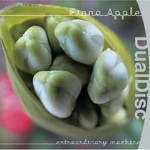Extraordinary Machine
Studio Album by Fiona Apple released in 2005Extraordinary Machine review
Two versions of Fiona Apple’s Extraordinary Machine
Fiona Apple's seeming insistence on courting drama has always had a way of overshadowing her music. Album number three, Extraordinary Machine, arrives on the heels of another newsworthy story. Originally recorded with producer Jon Brion more than two years ago, the album was shelved – either by the label or Apple herself, depending on the spin – and then almost completely redone with hip-hop producer Mike Elizondo (Eminem, 50 Cent, Dr. Dre, a sideman on records by Sheryl Crow, Gwen Stefani, and Avril Lavigne). Surprisingly, even after the delay, Extraordinary Machine didn't end up miles from those initial sessions or miles from Apple's last album, When the Pawn. It's another solid set of passionate, angry, marvelously produced songs delivered by a singular voice, and it succeeds by following a muse that doesn't just ignore genre distinctions and pop delineations – it doesn't know they exist.
A fine record, no matter who's sat behind the production desk
Extraordinary Machine is a fine record, no matter who's sat behind the production desk. The presence of Elizondo doesn't signal a move into hip-hop - rather this is Apple as her fans know and love her, belting out angst-ridden yet defiant songs from her piano and showcasing her articulate, if sometimes awkward, lyrical gifts. Brion's work does survive here, in the form of the two songs that bookend the album: the quirky title track and the equally ornate Waltz (Better Than Fine); both feature the string-laden orchestrations, arcane instrumentation and unconventional rhythms. The rest of the album is more typically Apple, although Elizondo does add some nice flourishes such as the dance beats on Tymps, which keep things nice and fresh. He gives the tracks energy with woodwinds, brass, guitars and swinging live drums. As usual with Apple, she works best with the epic ballad - O’ Sailor is absolutely stunning, featuring some wonderful piano work, a brooding atmosphere and some classic Apple lyrics, which see her baring her soul. Get Him Back berates a lover for failing to disappoint her, while the beautifully languid Red Red Red just drips in sadness and melancholy - Apple's voice being at its strongest here. She's also a great pianist, as the Ben Folds-like solo on Not About Love proves.
Extraordinary Machine may be more accessible, but it remains an art-pop album
Apple wrote much of Extraordinary Machine in the wake of her split from Paul Thomas Anderson, writer and director of Boogie Nights and Magnolia. The combination of this experience and just plain maturity – Apple released 1996's Tidal and 1999's When the Pawn... when she was eighteen and twenty-two, respectively – have helped to make Machine Apple's strongest and most detailed batch of songs yet. Extraordinary Machine may be more accessible, but it remains an art-pop album in its attitude, intent, and presentation — it's just that the presentation is cleaner, making her attitude appealing and her intent easier to ascertain, and that's what makes this final, finished Extraordinary Machine something pretty close to extraordinary. It was a tough call to follow an album as immense as When the Pawn…, but against all the odds Apple's pulled it off. Whatever the truth behind the album's delay, this is one record that's well worth the wait. Apple hasn't compromised, as some of her fans have feared; instead she's turned her label's interference into inspiration. Perhaps, one day, when Extraordinary Machine is declared a true classic, Apple will release a deluxe edition including both equally extraordinary versions of the album. Combined they could have been amazing.

